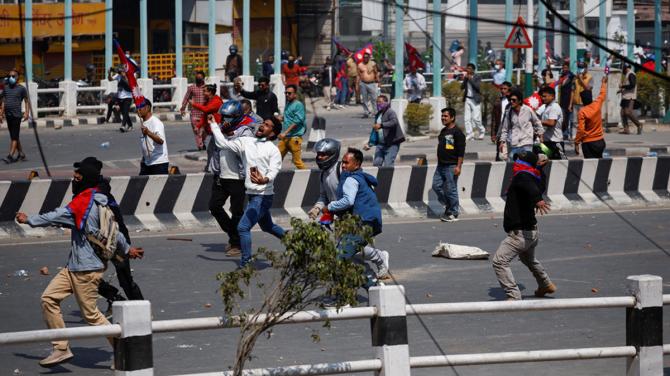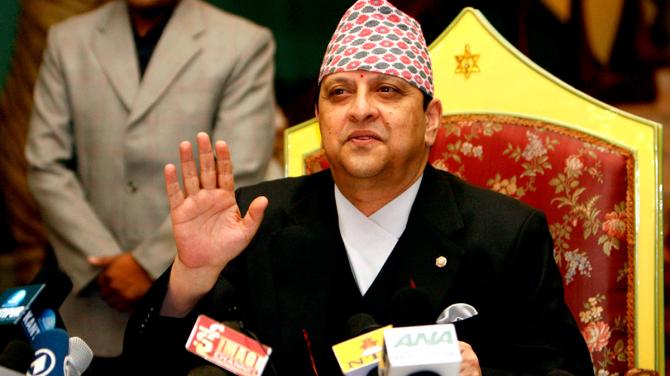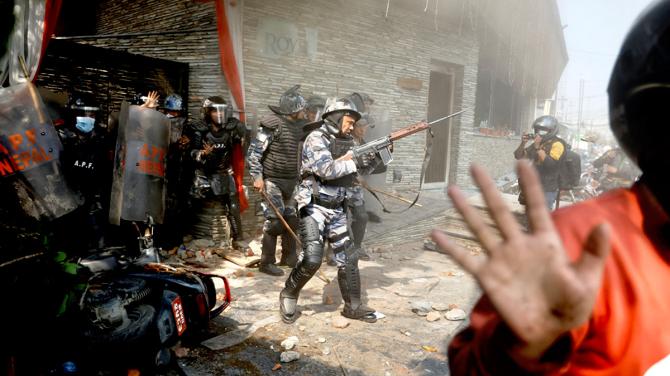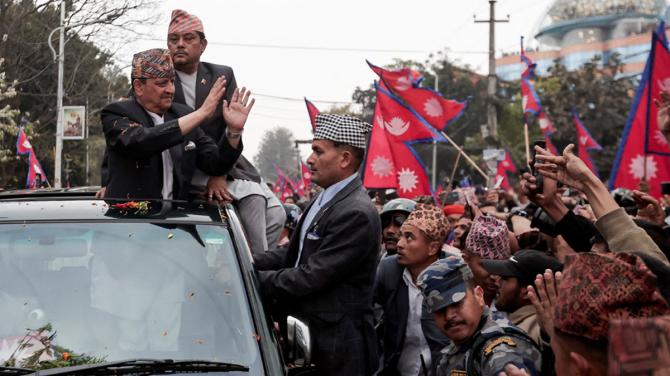From rediff.com (April 17, 2025)
By Nikhil Lakshman
‘Gyanendra back on the throne would be bad news for the Nepali people. He may not have learnt from his experience, but we have.’

The unexpected tone of violence during what was expected to be a routine-by-Kathmandu-standards protest to restore the monarchy in Nepal stunned many Nepalis, especially the incident where a mob set fire to a building with a television journalist trapped inside.
The K P Sharma Oli government was quick to react, arresting rioters, and leaders of the protests, slapping treason charges against some of them.
While it refrained from such action against Gyanendra, the former king in whose name the protest was undertaken, Kathmandu’s civic body nevertheless imposed a fine on the ousted monarch for ‘vandalism’. It also scaled down the security offered to Gyanendra.
On Friday, April 11, a fortnight after the rioting, the Nepal police announced the arrest of Durga Prasai, the so-called ‘commander’ of the protests, who had been on the run.
What happens next in Nepal? Can Gyanendra return to the throne encouraged by the perennial political ferment in Kathmandu — 13 prime ministers in the 17 years since the monarchy was abolished? Will the current Nepali constitution which promises a secular, democratic republic, be abolished and restore Nepal as a Hindu kingdom?
Kanak Mani Dixit is one of Nepal’s most distinguished journalists. Educated at Columbia University, he worked at the United Nations for several years before returning to Nepal where he founded the review magazine, Himal, now the Himal Southasian.
Nine years ago, in April 2016, he was arrested after he criticised the appointment of a former monarchist to head Nepal’s commission for investigation of abuse of authority.
“The former king seems to have been hoping that the ‘federal, secular, democratic republic’ would fail and he would be returned to the throne, but ten years into the implementation of the constitution of 2015, he seems to have decided that it was getting late, and himself getting on in age. There is no proof that the people want him back on the throne, the larger silent majority is obviously not with him,” Kanak Mani Dixit tells Rediff‘s Nikhil Lakshman in an interview conducted on WhatsApp and tweaked on e-mail.
What was the impetus for Mr Gyanendra to rouse the masses on March 28?
Was it meant to be another show of strength to buttress the message conveyed by the large number of people who gathered to welcome at the airport when he arrived from Pokhara? To tell Mr Oli’s government that after years of exile he had returned to reclaim his throne and the people wanted him there?
Well, it is a stretch to say that the masses were ‘roused’. There were some thousands gathered responding to ex-king Gyanendra’s call in his Democracy Day video appeal of February 2025: ‘Give me support if you want to save the nation’. Keep in mind that it was Gyanendra who, as king, did the most to bring down the monarchy in Nepal.
This he did by firstly conducting the coup in February 2005 and hence convincing all democratically minded parties and civil society that the monarchy was not to be trusted. They also remember well the 1960 coup by King Mahendra, which led to 30 years of the autocratic Panchayat system that ended only in 1990.
Secondly, in 2006 after the People’s Movement brought down the royal regime, he was offered the option of bowing out and allowing some descendant, a minor, to be placed on the throne. Gyanendra refused.
The former king seems to have been hoping all along that the ‘federal, secular, democratic republic’ would fail and he would be returned to the throne, but ten years into the implementation of the constitution of 2015, he evidently decided that it was getting late, with himself getting on in age.
He therefore decided to utilise the following categories of individuals for the revival of monarchy: Old ‘panchas’ — members of the old Panchayat hierarchy; newborn political opportunists who rely radical populism; and politicians who had failed to gain traction in electoral politics.
Mostly, those without ideology, but with ample supply of opportunism and romanticism, decided to exaggerate the failures of republican governance. They have tried to use social media for the purpose, to claim that Nepal’s politicians are destroying social and economic prospects of the people, hoping that a populist surge will bring down the constitutional system down.
There is no evidence that the people want Gyanendra back on the throne, the larger silent majority is certainly not with him. On the whole, I believe the ex-king and his supporters have realised that they are not getting the momentum they thought they could generate.
Further, the violence of the royalist rallyists on the streets exposed them in the eyes of the people, and you may notice that there is no countrywide movement for the return of kingship.
It is not that the political parties are doing right, but that the population does not see revival of monarchy as the answer. Nepal’s youngsters may not know, but the elders have experienced what it was like under the monarchy, ‘constitutional’ or otherwise, which delivered nothing but closed society, unaccountability, militarism, a police society, and corruption at the highest places.
If you followed Indian television media, of course, you would think that there is a Hindutva wave in Nepal, and indeed it is Indian television that has been carrying Gyanendra on its shoulders.
Much of that is based on wishful thinking of Hindutva activists and political leaders in India, who hope to use the ex-king to propel Nepal back to being declared a ‘Hindu State’. The hope is that such a declaration, while it would destroy Nepal’s decade-old constitution, would benefit the BJP’s electoral prospects, also useful for the upcoming election in Bihar.

Have the violent events of March 28 been a setback for the former king? Are ordinary Nepalis shocked by what happened?
The violent events of March 28, plus what has transpired since in terms of exposing the key players selected by the ex-king to lead his ‘movement’, have definitely set him back.
To begin with, the events showed the royalist flank to be made up of either superannuated individuals out of touch with ground reality, or unprincipled, violence-prone goons.
Secondly, the ex-king blatantly bypassed the very political parties and personages who have been carrying the royalist flag the past decades against all odds. Instead, he chose a retired octogenarian ‘pancha‘ and a boorish businessman to lead the charge.
This has left the royalists in disarray and disheartened the experienced politicos and parliamentarians.
Do you believe Mr Gyanendra dictated the ways to run the March 28 protests? Was this the way it was meant to unfold or did the protest spiral out of control under poor leadership at the street level?
It would be too much to say that Gyanendra personally directed the violence of March 28, but it was his chosen lot who carried it out. He would have to take moral responsibility for what transpired because he selected the front-rank — the old time ‘pancha‘ Nabaraj Subedi and the coarse-tongued rabble-rouser Durga Prasai as ‘commander’.
The fact that Gyanendra did not turn to the experienced leadership of the ‘royalist’ parties such as the RPP (Rastriya Prajatantra Party) and its leader Rajendra Lingden, or Kamal Thapa of the breakaway RPP, meant that he wanted the movement for royalist restoration to run under his own direction rather than through the political parties in parliament.
In your estimation, who constituted the bulk of the protestors? Were they genuine supporters of a restored monarchy?
The protestors at large would mostly be made up of frustrated youth who have, firstly, been impacted by conspicuous consumption of the wealthy of Kathmandu, the corruption of the political elite widely reported by the media, who have only the prospect of going overseas for labour, and who have been impacted by the negativity spreading algorithms of social media. Everyone is scrolling all the time.
Further, the newborn political parties with supposedly youthful political leaders have not been able to assuage the frustrations of the youth on the street. The new politicos of Nepal are mostly self-publicists hoping the ride the waves of social-media led populism.
Neither have the new and old political forces of the Tarai/Madhes plains been able to spark the imagination of the youth. Hence, there are people on the street whose white-hot anger could be plumbed, or so thought the royalists.

The K P Sharma Oli government has filed cases of treason against some leaders of the restore monarchy movement.
If the government believes that these individuals were plotting against the State, why has it not filed the same charges against Mr Gyanendra in whose name this protest was undertaken?
Gyanendra can always say that he was not on the ground when the violence has happened, although calls for his interrogation and the withdrawal of State support for his lifestyle has now risen in parliament like never before.
Right now, Nabaraj Subedi is under house arrest, Rabindra Mishra and Durga Prasai are in police custody. I believe Gyanendra should be questioned for his activities which amount to instigation, if not direction.
What you need to understand is that Gyanendra’s call for a ‘movement’ for the return of monarchy is actually a demand for the dismantling of the constitution of Nepal, something that would have grave ramifications through political instability, economic downturn and social polarisation.
Taking away the ‘republic’ to make way for a constitutional monarchy would come part and parcel with cancellation of ‘secularism’ to allow a ‘Hindu State’ to be formed, which means a dismantling the constitution and all kinds of unintended consequences.
People who say that the demand is only for restoration of constitutional monarchy and not for absolute monarchy fail to remember that this is the very ex-king who as constitutional monarch under the 1990 constitution carried out the 2005 coup against parliamentary democracy.
As the selfsame gentleman, there is no doubt that Gyanendra would take on the powers of autocratic monarchy were he to be placed back on the throne.
Not once has Gyanendra expressed regret for his 2005 takeover, the jailing of political leaders and civil society persons, and the cancellation of parliament. Nor has he ever been accountable for the excesses carried out by the armed forces during the time he ran the government as ‘chairman’ of the council of ministers.
Even today, he and his supporters hope for loyalists within the Nepal army to side with the royalists, which only indicates that they do not have a proper political, demographic or political understanding of the polity. Theirs is only a hope for revival of lost glory.
Why would no government in Kathmandu directly take on a former monarch? What would it be wary about?
Would they be fearful that such an action (filing treason charges) would gain sympathy for Mr Gyanendra and provide ballast to his campaign?
Even if the government does not bring a case against Gyanendra, taking to court those who wrought violence while campaigning against the constitution should suffice.
However, a parliamentary committee or a duly authorised commission of enquiry must question him on his role, and seek his views. He may be ex-king, but he is now a citizen with rights and duties like 30 million other Nepalis.
The timing of Mr Gyanendra’s current gambit: What is it driven by? Does he recognise the possibility of a deep disenchantment among the Nepali public with the brittle state of government, the multiple prime ministers who have come and gone?
Perhaps he senses that the people would like a return to the monarchy. Is he right in thinking this or is this just wishful thinking?
Gyanendra is delusional in more ways than one, and that has been his trait as seen in 2005-2006. He must have thought that the frustrations of youth and the countrywide disenchantment with the political parties would propel him back towards the crown.
He must also have believed that his reception by Hindutva forces of India, including Chief Minister Adityanath, would give him momentum in Nepal.
Here we have the 12th descendant of the King Prithvinarayan, who consolidated the kingdom while counseling distance from the two great empires of the north and south, blatantly seeking support of political forces of India for a return to the throne.
Gyanendra is willingly using the excuse of weak governance by the political parties to try and dismantle the constitutional regime in place, hoping there will be a populist upsurge fueled by discontent ratcheted up by social media.
This is an attempt at over-correction for self-gain. The failure in governance should lead to demands for better performance by the political parties, or demand for start-up of new parties where the old are seen to have failed.
Instead, Gyanendra and his band of royalists would want to bring down the constitutionally mandated system itself. That cannot be allowed, in the name of democracy and constitutionalism.
The desire for a revival of the throne on the part of Gyanendra and his followers is understandable, but the timing of the ex-royal’s push is obviously driven by real or perceived desires of the BJP government in New Delhi and CM Adityanath in Lucknow.

IMAGE: Nepal’s former king Gyanendra is welcomed by pro-monarchy supporters outside the Tribhuvan international airport in Kathmandu, March 9, 2025. Photograph: Navesh Chitrakar/Reuters
In your calculation, how many Nepalis would like the monarchy to be restored?
This is a suggestion that is often made by the royalists, that a referendum be conducted. However, referendum on crucial matters of State, including constitutionalism and protection of minorities, is a bad idea.
Look at how the British population went against its own interest on sentimental grounds when it voted for to leave the European Union with Brexit. You cannot have a plebiscite where people at large are asked to decide on the basis of atmospherics.
The way to conduct mature politics, including on matters relating to constitutionalism, is through parliamentary elections, where people understand and tend to vote on issues rather than on the basis of populist sentimentalism.
And so, the process of defining future of the Nepali state including the place of monarchy within it, is a matter that has been codified in the constitution. It means gaining enough trust of the electorate to get enough votes in parliament to push through a constitutional amendment through two-thirds majority.
Looked at through this window, you will note that the royalist parties in Nepal have a small base. Presently, the RPP party has 13 seats in the federal parliament’s Lower House of 275 MPs.
What happens next? Will March 28’s shocking violence compel the former king and his supporters to back off from another quick confrontation? Or will they be itching for another fight that in their calculation could bring him closer to power?
On the whole, as long as New Delhi overtly and covertly keeps its hand off Nepal, I believe the so-called royalist surge in Nepal, such as it is, will subside.
This will also happen because the leadership of the two main political parties — the Congress and the UML (Communist Party of Nepal [Unified Marxist-Leninist) — have been unequivocal in their position regarding the ex-king.
There is a flank within the Congress party that is conservative and even claims to be royalist, but much of that for the moment is posturing against the present party establishment led by Chairman Sher Bahadur Deuba.
Is there any way the monarchy could be restored? Or has that boat long sailed? If it has sailed, what is Mr Gyanendra hoping for then?
If you look at the statement eight of us democracy activists put out on March 24, 2025, we state: ‘Gyanendra Shah, the former king, has become politically active with the aim of reinstating monarchy in Nepal, which we the undersigned regard as being against the Constitution, aimed at sowing lawlessness for the benefit of opportunists, and carried out with the backing of religious fundamentalists in India.’
In that same statement, we maintain that Gyanendra could have hoped for a generous and dignified place within the Nepali polity for the Shah clan, as direct descendants of the King Prithvinarayan, and recognised by the people as well as the State, but outside of the constitution.
For this, the precondition was that he eschew playing politics. He has gone and played his hand, and we believe there is now no reason to provide that kind of place for the clan.
Is he being encouraged in his ambition by individuals in the Indian establishment, as is alleged in some quarters? Who would these individuals be and what would they hope to gain from trying to restore the monarchy?
Would such individuals have Prime Minister Modi’s sanction?
For sure, Gyanendra was encouraged in his ambitions by power brokers and leaders in the Indian establishment, particularly in New Delhi and Lucknow.
To repeat, they would gain from the restoration of a monarchy in Nepal because that would come part-and-parcel with Nepal being declared a ‘Hindu State’ with a Hindu monarch, which would help electoral calculations of the BJP/RSS combine.
Lived experience indicates that the BJP/RSS power centres would want this type of evolution of the Nepali polity, but keep in mind they would not leave a paper trail and would also be quick to distance themselves if the Gyanendra balloon bursts.
While Gyanendra hopes to take advantage of India’s ultra-right Hindutva brigade, the latter would want Gyanendra to succeed but refuse to take any blame if the royalists did not gain momentum.
At a time when the South Asian neighbourhood is fraught for the Modi government, it will not want to be seen to be interventionist even when it is.
One does not know what Mr Modi thinks, but the blockade conducted in 2015 indicates that he is not shy when it comes to using coercive methods on a smaller neighbour.
On the other hand, times have changed, and the much-disliked constitution has got staying power, and it is today owned by diverse groups beyond the royalist flank, including the Madhesi, Janajati, Dalit, Muslim and other communities.
Given the lack of understanding of Nepal among India’s relevant categories — from unaccountable intelligence apparatchiks, ranting television anchors, clearly self-interested RSS/BJP operatives, and a Congress party that seems to fear taking a position on Nepal — India may yet blunder into supporting a crisis that is not at all in its interest.
An unstable Nepal can only impact the political-economy of the adjacent states of India.
My own suggestion is that the New Delhi regime take steps to overtly distance itself from the royalist forces in Nepal and erase the solidifying perception among Nepal’s citizenry of its anti-republican tilt.
Have you ever met Mr Gyanendra? Has he never come to terms with being ejected from the throne?
I have met Gyanendra twice, and both times I have come away believing that he is anti-democracy, detests political parties, and has a superior evaluation of his own wisdom and capacities.
Gyanendra sent word to me after the 2005 coup d’etat with the offer of being minister of information and communication in the regime he chaired, which, of course, I rejected.
It was army officers acting on his command who came to the editorial rooms of newpapers and magazines, including one that I published, seeking to censor our content. He shut down the internet and all telephony, international telecommunications.
It was under the his direct orders that the military and police were activated to imprison hundreds of political leaders and us civil rights activists.
With this experience, I can tell you that Gyanendra back on the throne would be bad news for the Nepali people. He may not have learnt from his experience, but we have.

What happens to Nepal in the short term? What would you advise the perennially squabbling politicians to do if they have to avert the likelihood — however remote — of the monarchy being restored by popular disillusionment with the way politics has operated in Nepal in the last decade?
Nepal’s perennially squabbling politicians are certainly a bane, but that is also proof that we are not an autocracy like much of the rest of South Asia.
One extra reason for unstable politics, apart from foreign interventionism and the incapacities of political leadership, is the electoral system under the 2015 constitution makes it difficult for parties to make a majority government, which gives mischief making powers to smaller parties like the Maoists of Pushpa Kamal Dahal (known to many as ‘Prachanda’).
Nepal is not doing as badly as a republic as it is made out, and certainly is doing much better that it would ever as under an autocratic monarch. Neither is Nepal’s record negative in terms of the indices of equity, economic growth, democracy and open society, when compared to the neighbouring countries.
In particular, socio-economically, Nepal fares better than the neighbouring states of India, viz. Uttar Pradesh, Bihar, Jharkhand, and so on.
Internally, the political parties have to try and govern better, tackling corruption, making federalism work, and doing away with the ‘winner-takes-all’ in constitutional and other appointments.
All of this will help create a stable Nepal, one that will remain naturally friendly to India
Is democracy, constitutionalism and secularism in danger in Nepal under the current circumstances with a former monarch itching to return to the old ways?
It is not in danger, because the ex-monarch has been found out. But Nepal remaining a republic does not mean that we should go back to politics-as-usual.
The long-suffering people of Nepal deserve better, with stable government, economic growth and eradication of social ills.
